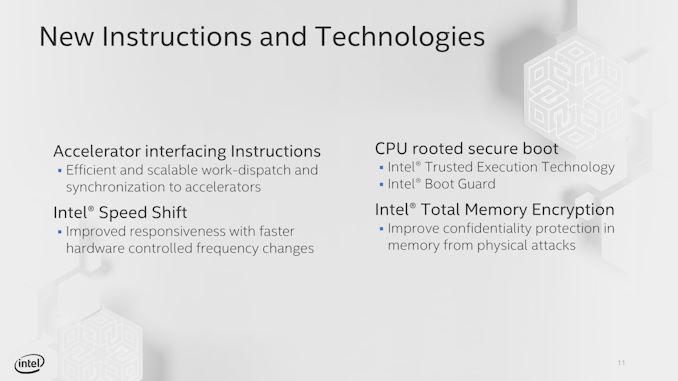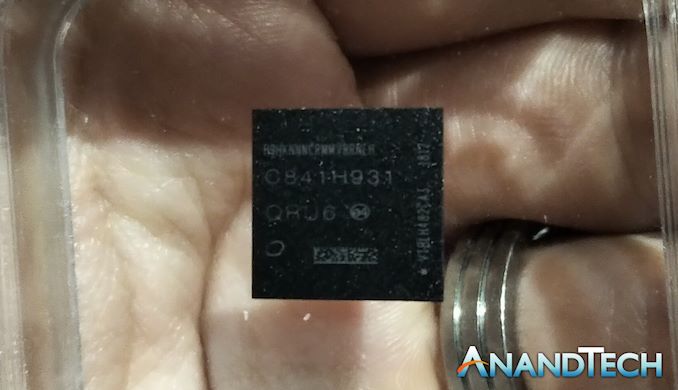Intel's new Atom Microarchitecture: The Tremont Core in Lakefield
by Dr. Ian Cutress on October 24, 2019 1:30 PM ESTBeyond the Core
Nominally today’s disclosure is more about the Tremont microarchitecture than any SoC it might appear in, like Lakefield or Snow Ridge. To that end, Intel wasn’t talking about GPU support (Lakefield will have Gen11 graphics), but Intel did discuss that Tremont would be the first Atom design to fully support Intel’s Speed Shift / ACPI hardware flags, allowing for faster ramp-up and ramp-down of high-frequency operation.
Intel also stated that Tremont supports Total Memory Encryption to prevent physical attacks, Rooted Secure Boot and Boot Guard, and specific accelerator interfacing instructions. With respect to Spectre, Meltdown, and L1TF, Intel stated that Tremont will have the same protections as Cascade Lake.
We also asked Intel about module-level voltage and power control. We were told that within a quad-core module with four Tremont cores, all the cores share the same frequency plane, but each core can enter separate c-states to reduce power consumption when not in use.
Final Thoughts and Slide Deck
In the past, at least from my perspective, dealing with Atom platforms has been amusing. Atom devices typically work great for hyper-focused and optimized software that can take advantage of a latency-insensitive workload, such as networking equipment or a NAS, but for any general purpose use I find them incredibly slow. Perhaps I’m just too used to the big cores on the devices I use – but with Intel saying that Atom is being refocused on performance, it will be interesting to see how Tremont devices and other Core devices will overlap. This graph from Intel is very striking, and if you squint, it looks a lot like some of the smartphone power/performance graphs we’ve produced in the past.
With Intel moving Core down in power to the 1.5W level, again it will be interesting to see how Tremont can play in that 2mW to 2W range that Atom has traditionally played in. The last generation Goldmont Plus devices were going beyond that, and in this power range we also have smartphone cores coming into play. After showing the slide deck to Andrei, we were discussing how a Tremont might stack up against an Arm Cortex A76, or a Kryo core. When we can get our hands on Tremont, we’ll see how they compare. When it comes to the products that Tremont is aiming for however, it still has that x86 advantage.
We did ask a few questions from Intel that we didn’t get answers to, such as die size and target frequencies. The other question to discuss is Intel’s current high-demand issues putting pressure on its manufacturing technologies. Tremont is still a low cost, low powered core, so logic may dictate that it will be a while before we see consumer chips enter the market. Ultimately Intel’s high-demand issues are around 14nm, and so far we’ve only seen Tremont discussed on Intel’s 10+ process with Lakefield and Snow Ridge. What we know about Intel’s 10nm/10+ capacity isn’t a lot, but reports vary from yields being ‘on track’ to ‘working with key OEM partners only’. Intel’s driver for 10+ right now is Ice Lake, which is coming to some premium notebook designs this year, and Lakefield has been announced for the Surface Neo. It is not known what the expected volume for the Neo will be, but it is unlikely to be large. Whether or not Tremont will see the light of day in traditional Atom Celeron and Pentium processors is another question entirely – the Goldmont Atom families have suffered while Intel’s 14nm efforts are more focused on enterprise hardware that can be sold for a much higher $$ per square millimeter. Beyond Lakefield, we might not actually see Tremont in any other consumer chip before the next generation Atom if Intel cannot get its issues sorted.
As and when we get a Lakefield device, we will put it through our tests. Stay tuned.













101 Comments
View All Comments
29a - Thursday, October 24, 2019 - link
Did Atom processors ever stop sucking?solidsnake1298 - Thursday, October 24, 2019 - link
That depends on your needs. As a HTPC, starting with Apollo Lake (Goldmont) the iGPU was upgraded sufficiently that it can decode 4K HEVC. I haven't tested 4K HEVC, personally. But I have played 1080p60 HEVC without a single dropped frame.vladx - Friday, October 25, 2019 - link
I have a Goldmont tablet, 4K HEVC works fine as long as the bitrate doesn't surpass the limits of its eMMC storage, in which case artefacts and stuttering is present. Maybe I should look into replacing it with a SSD if that's even possible.qap - Friday, October 25, 2019 - link
Even the slowest eMMC storage can do 50MB/s sequential read. There is no way, you have 400Mbps+ HEVC video (and if that is the case, Atom is obviously not for you). The limit must be somewhere else. Most likely it supports hardware HEVC decoding up to some bitrate only and you are hitting this limit.vladx - Friday, October 25, 2019 - link
400Mbps no, but I have some 100+ Mbps videos and most sit around 60 so it can definitely push the eMMC to its limits especially considering it also needs to run the OS processes at the same time.s.yu - Friday, October 25, 2019 - link
A common confusion between B and b...eddman - Friday, October 25, 2019 - link
Unless the storage is so crap that can't even sustain 12.5 MB/s (a.k.a 100 Mbps), it's probably the decoder itself that is unable to properly accelerate such high bit-rate videos.nathanddrews - Sunday, October 27, 2019 - link
Quite a few eMMC implementations run off a USB 2.0 bus, so yes, it can bottleneck a system hard. Same thing frequently happens with networking components in devices. It will have AC/GbE, but can't reach those speeds.eddman - Sunday, October 27, 2019 - link
Even a USB 2.0 eMMC should be able to sustain a 12-13 MB/s sequential read.It has to be the decoder. He doesn't know the difference between bit and byte and thinks 60 Mbps is too much for 50 MB/s.
eek2121 - Monday, October 28, 2019 - link
Not if the bus is shared with 2 network controllers, a bluetooth controller, etc. I haven't looked at how Atom is set up admittedly, but that is one of the major issues with SBCs. Everything hangs off the USB 2.0 bus. The USB 2.0 bus also can't really maintain true USB 2.0 speeds in quite a few cases due to hitting micro-usb power limits.